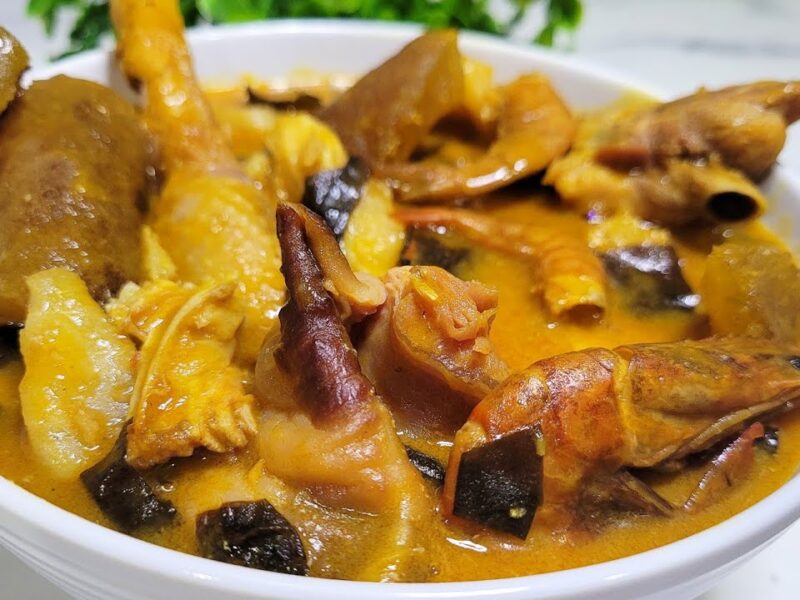Owoh soup, often spelled “Owo,” is a traditional dish from the southern regions of Nigeria, particularly among the Urhobo, Isoko, and Itsekiri people of Delta State. This rich and flavorful soup is celebrated for its distinctive taste, thick texture, and cultural significance. Owoh soup is a staple at family gatherings, festivals, and special occasions, where its unique preparation and ingredients bring people together. This comprehensive guide delves into the origins, ingredients, preparation methods, cultural importance, and health benefits of Owoh soup.

Origins and Cultural Significance
Historical Background
Owoh soup has a long history rooted in the culinary traditions of the Urhobo, Isoko, and Itsekiri ethnic groups. It is traditionally prepared during significant events such as weddings, festivals, and communal celebrations. The dish holds a place of honor in the cultural heritage of these communities, symbolizing unity, hospitality, and the richness of their culinary practices.
Regional Variations
Although Owoh soup is primarily associated with Delta State, there are variations in its preparation and ingredients across different regions and families:
- Urhobo Style: This version often includes a generous amount of smoked fish and bush meat, giving it a robust and smoky flavor.
- Itsekiri Style: The Itsekiri people might incorporate more seafood, reflecting their coastal environment. Crabs, prawns, and periwinkles are common additions.
- Isoko Style: Known for using a variety of local spices and seasonings, the Isoko version can be spicier and more intensely flavored.
Cultural Celebrations
Owoh soup is more than just a meal; it is a centerpiece at many cultural celebrations. It is traditionally served during the annual Iri Ji (new yam) festival, marriage ceremonies, and other important communal gatherings. Preparing Owoh soup is often a communal activity, with family members contributing to the process, thereby reinforcing social bonds and cultural continuity.
Ingredients and Their Nutritional Benefits
Core Ingredients
- Palm Oil: This is a key ingredient, providing the soup with its characteristic rich color and flavor. Palm oil is a source of vitamins A and E, which are vital for vision and skin health.
- Ground Crayfish: Crayfish adds a depth of flavor and is rich in protein and minerals such as calcium and magnesium.
- Smoked Fish: Often used to enhance the soup’s smoky flavor, smoked fish is a good source of protein and omega-3 fatty acids.
- Potash (Kaun): Potash is used to thicken the soup and give it its unique texture. It also helps in softening the proteins, making the meat more tender.
- Seasoning Cubes and Spices: These include salt, pepper, and other local spices that contribute to the overall flavor profile of the soup.
- Meat and Fish: Assorted meats such as goat, beef, or bush meat, along with fish like catfish or tilapia, are commonly included for protein and flavor.
Optional Ingredients
- Seafood: Prawns, crabs, and periwinkles can be added for a coastal twist.
- Yam or Plantains: These can be used as thickeners or served alongside the soup for a complete meal.
- Local Herbs and Leaves: Adding herbs like scent leaf or bitter leaf can enhance the flavor and nutritional content.
Preparation Methods
Traditional Preparation
- Preparing the Ingredients:
- Clean and cut the meats and fish into manageable pieces.
- Grind the crayfish and set aside.
- Prepare potash by dissolving it in a small amount of water and setting it aside.
- Measure out the palm oil and other seasonings.
- Cooking the Meats:
- In a large pot, cook the assorted meats with seasoning cubes, salt, and a bit of water until tender.
- Add the smoked fish and allow it to cook together with the meat to infuse its flavor.
- Making the Soup Base:
- In a separate pot, heat the palm oil gently and add the ground crayfish.
- Stir in the dissolved potash gradually, ensuring the mixture doesn’t become too thick or too runny.
- Add the cooked meat and fish along with some of the stock from cooking the meat.
- Combining and Simmering:
- Allow the mixture to simmer, stirring continuously to prevent sticking and ensure even cooking.
- Adjust the seasoning with salt, pepper, and additional seasoning cubes as needed.
- Continue to cook until the soup thickens to the desired consistency.
- Final Adjustments:
- If using seafood, add it at this stage and cook until done.
- Adjust the consistency by adding more water or stock if necessary.
Modern Variations
- Pressure Cooker Method: Use a pressure cooker to reduce cooking time for the meats, ensuring they are tender and flavorful.
- Healthier Alternatives: Reduce the amount of palm oil used or substitute with a mix of palm oil and vegetable oil to lower saturated fat content.
- Vegetarian Owoh Soup: Replace meat and fish with mushrooms, tofu, or plant-based protein sources for a vegetarian version.
Serving Suggestions
Owoh soup is traditionally served with a variety of Nigerian staples:
- Starch: A common accompaniment is starch (a dough-like consistency made from cassava), which pairs perfectly with the thick soup.
- Pounded Yam: This is another popular side that complements the rich flavors of Owoh soup.
- Eba (Garri): Made from cassava flour, eba is a convenient and easy-to-prepare side.
- Fufu: Also made from cassava, fufu is another staple that goes well with Owoh soup.
- Boiled Plantains or Yam: These can be served alongside the soup for added variety and texture.
Health Benefits of Owoh Soup
Nutrient-Dense Ingredients
- Palm Oil: While it should be consumed in moderation due to its high saturated fat content, palm oil is a good source of vitamins A and E, which support immune function and skin health.
- Crayfish: Rich in protein and essential minerals, crayfish contributes to muscle repair and overall health.
- Assorted Meats and Fish: These provide high-quality protein and essential amino acids, which are crucial for muscle building and repair.
- Local Spices: The spices and seasonings used in Owoh soup not only enhance flavor but also offer various health benefits, including anti-inflammatory properties and improved digestion.
Balanced Meal
Owoh soup, when paired with a starchy side like pounded yam or starch, offers a balanced meal with carbohydrates, proteins, and fats, along with essential vitamins and minerals.
Weight Management
The high protein content in the soup helps in maintaining satiety and can aid in weight management by reducing overall calorie intake.
Blood Sugar Control
The complex carbohydrates in pounded yam, fufu, and other sides release glucose slowly, helping to maintain stable blood sugar levels, making Owoh soup a suitable option for individuals managing diabetes.
Tips for Making the Perfect Owoh Soup
- Quality Ingredients: Use fresh and high-quality ingredients to ensure the best flavor and consistency.
- Moderate Use of Potash: Use potash sparingly to avoid making the soup too thick or altering its flavor too drastically.
- Consistent Stirring: Stir the soup frequently to prevent it from sticking to the pot and to ensure even cooking.
- Balance Seasonings: Add seasonings gradually and taste frequently to avoid over-seasoning.
- Experiment with Additions: Feel free to experiment with different proteins and vegetables to suit your taste preferences and nutritional needs.
Conclusion
Owoh soup is a quintessential Nigerian dish that embodies the rich culinary traditions and cultural diversity of the southern regions. Its unique texture, flavorful ingredients, and nutritional benefits make it a beloved meal across various communities. Whether enjoyed with starch, pounded yam, or any other staple, Owoh soup offers a satisfying and wholesome dining experience. By following traditional preparation methods and incorporating modern variations, you can enjoy this delicious soup while reaping its numerous health benefits. Embrace the flavors of Nigeria and add Owoh soup to your culinary repertoire for a taste of authentic Nigerian cuisine.










